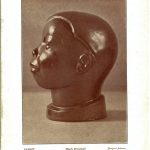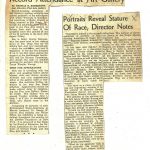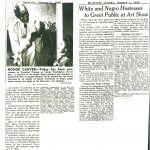
When wealthy real estate developer William Elmer Harmon founded the Harmon Foundation in 1922, it originally supported causes as varied as playgrounds, biblical films and nursing programs. But it is better known today as one of the first major supporters of African American creativity and ingenuity.
Harmon grew up in the Midwest, where his father was an officer in the 10th Cavalry regiment, a black unit known as the Buffalo Soldiers. Growing up among the soldiers likely had an impact on his attitudes toward blacks, and in particular, Harmon himself became interested in supporting them after meeting an artist who was unable to sell his paintings because of his race. The Harmon Foundation gained its now well-known focus in 1925 when it began presenting cash awards to blacks for distinguished achievements in eight fields: business, education, fine arts, literature, music, race relations, religious service, and science. Between 1928 and 1933, the Foundation was one of the first to give national recognition to the achievements of African Americans.
It is best known for its impact on African American art of the Harlem renaissance. Only a few years after the first awards were presented, the annual program was receiving such large numbers of high-quality art works that the Harmon Foundation began organizing a corresponding exhibition to provide an opportunity for the candidates to show and sell their work. These awards exhibitions gained even more national attention when they were toured to art museums, colleges, public libraries, and even YMCAs all around the country.


Among the many recipients of the awards were Countee Cullen, Claude McKay, Langston Hughes, James Weldon Johnson, Laura Wheeler Waring, Sargent Johnson, and Walter White. Hale Woodruff and Palmer Hayden were the very first recipients of the William E. Harmon Foundation award for Distinguished Achievement among Negroes for fine arts.
The Foundation did face criticism for actually perpetuating racial segregation in its all-black exhibitions and for patriarchal practices, in particular, using mostly white juries. Artist Romare Bearden wrote a scathing opinion article in 1934 in which he accused the Foundation of coddling artists and lowering artistic standards. The Harmon Foundation did later shift its focus from the awards to different avenues of support for black artists. But during its existence, the purpose of the awards was to stimulate creative achievement among and to bring attention to the work being accomplished by African Americans, and it became almost synonymous with Negro visual art.

When the Foundation closed in the 1960s, it dispersed its considerable art collection among several institutions, including the Smithsonian’s American Art Museum and brand new National Portrait Gallery. Those conducting research or just simply interested in the artists supported by the Harmon Foundation over the years have a great wealth of information available to them at the Smithsonian Institution. The AA/PG Library has many of the rare original exhibition catalogs from the 1920s prizes, numerous books on the Harmon Foundation and African American artists in general, as well as Art & Artist Files for the Foundation and many of the Harmon winners, in addition to archival material donated to the library when the Foundation closed.

Works consulted include:
Against the odds: African-American artists and the Harmon Foundation / / Gary A. Reynolds and Beryl J. Wright. Newark, N.J.: Newark Museum, 1989.
“Breaking Racial Barriers: African Americans in the Harmon Foundation Collection” 1997 National Portrait Gallery exhibition website and exhibition catalog.
Encyclopedia of African-American Culture and History. New York: Macmillan Library Reference, 1996.
Harmon Foundation Art & Artist File, Smithsonian American Art Museum/National Portrait Gallery Library, Washington D.C.
Library of Congress Finding Aid for the “Harmon Foundation, inc., records, 1913-1967” collection

11 Comments
I thought you might be interested in the blog post I did about William E. Harmon after discovering your post yesterday. Residents of Croton-on-Hudson have all heard of William’s brother Clifford—part of the village was originally Harmon-on-Hudson—but even the local expert on Harmon knew nothing about William’s philanthropic activities.
Hi Marc~
Thanks for posting! The Harmons were quite the family. And it sounds like your town is chock full of interesting history!
http://crotonhistory.org/2013/03/05/the-other-harmon/
I am a researcher and librarian with a particular interest in American art with a specialization in African American art. Thank you for this post, highlighting the Harmon Foundations and artists of the period many of whom have been become groundbreaking artists and masters in the field.
In addition, this post brings to the public’s attention the rich resources that are a part of the AA/PG Library’s collection. The depth, coverage, and focus of your various collections truly support the study and understanding of American art and many complementary areas such as photography, furniture, the decorative arts, architecture, and etc. More specifically, “African American Art and the Harmon Foundation” is a classic example of the depth, including catalogues and ephemera that you have of materials that focus on specialized areas such as African American art.
[…] skill in creating dramatic portraits. In 1933, he received the Schomburg Portrait Prize, from the Harmon Foundation, for the painting entitled “Woman Holding a Jug” (1930). Porter drew inspiration from his […]
[…] of the two. He taught art in the Philadelphia public schools, exhibited at the Pyramid Club and the Harmon Foundation in the early 20th century, and has artwork in major museums, including the Philadelphia Museum of […]
I am researching Wm. H. Johnson’s paintings that you donated to the Smithsonian. Who can tell me how you saved his collection, where can I find a catalog of the works, what is the history of the paintings showing his early days in S.C.????
I am researching Wm. H. Johnson’s paintings that you donated to the Smithsonian. Who may I contact to find out about when, where you found them, is there a catalog available documenting the collection?
see above
[…] Anne. “African American art and the Harmon Foundation.” Smithsonian Libraries and Archives. February 22, […]
[…] had its origins in the dissatisfaction of African-American artists with the activities of the Harmon Foundation, and was described by co-founder Alston as “a pressure group to get more black artists […]
Dr. John McFall, wrote about William Harmon’s philanthropy to organizations in Charleston, S.C. Apparently, Harmon spent winters in Adams Run, a rural section of Charleston County. He also wrote of the Harmon Art Exhibit held at Fisk University and about a posthumous award made to Charleston artist, Edwin Harleston. McFall’s manuscript was published in 2021: Resisting Jim Crow: The Autobiography of Dr. John A. McFall.